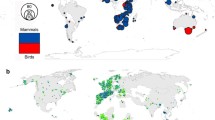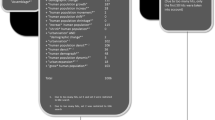Abstract
Human population size and growth have been recognized as important factors affecting biodiversity, but the impacts of population structural changes on biodiversity are not clear. In this paper, we made the first attempt to link human population structural changes with implications for biodiversity, using Wolong Nature Reserve (south-western China) for the endangered giant panda as a case study. From 1982 to 1996, the labor force (20–59 years of age) in the reserve jumped by 59.76 percent, although the total population size increased by only 14.65 percent. During the same time period, the sex ratio (males:females) of small children (0–4 years of age) changed from 0.98∶1 to 1.20∶1, and the percentage of children receiving education beyond the elementary school level increased from 14.04 to 27.47. The increase in labor force and the number of male-biased children could have more negative impacts on the panda habitat, whereas improving school education could help more young people move out of the reserve by going to college and finding jobs elsewhere and thus reduce destruction to the panda habitat.
Similar content being viewed by others
References
Bancroft, G. T. (1989). Status and conservation of wading birds in the Everglades.American Birds, 43, 1258–1265.
Bancroft, G. T. (1996). Case studies: United States. In V. Dompka (Ed.)Human population, biodiversity and protected areas: Science and policy issues (pp. 199–216). Washington, DC: American Association for the Advancement of Science.
Cheever, F. (1997). Human population and the loss of biological diversity: Two aspects of the same problem.International Journal of Environment and Pollution, 7, 62–71.
China's Ministry of Forestry and WWF (1989).Conservation and management plant for giant pandas and their habitat. Beijing, China. (In Chinese.)
Cruz, M. C. J. 1996. Management options for biodiversity protection and population. In V. Dompka (Ed.)Human population, biodiversity and protected areas: Science and policy issues (pp. 71–90). Washington, DC: American Association for the Advancement of Science.
Dompka, V. (Ed.). (1996).Human population, biodiversity and protected areas: Science and policy issues. Washington, DC:American Association for the Advancement of Science. Ehrlich, P. R. (1988). The loss of diversity: Causes and consequences. In E. O. Wilson (Ed.).Biodiversity (pp. 21–27). Washington, DC: National Academy Press.
Ehrlich, P. R., & Holdren, J. P. (1971). Impact of population growth.Science, 171, 1212–1216.
Giant Panda Expedition (1974). A survey of the giant panda (Ailuropoda melanoleuca) in the Wolong Natural Reserve, Pingwu, Northern Szechuan, China.Acta Zoologica Sinica, 20, 162–173. (In Chinese.)
He, N., Liang, C., & Yin, X. (1996). Sustainable community development in Wolong Nature Reserve.Ecological Economy, 1, 15–23.
Holdren, J. P., & Ehrlich, P. R. (1974). Human population and the global environment.Am. Sci., 62, 282–292.
Liu, J., Ouyang, Z., Taylor, W., Groop, R., Tan, Y., & Zhang, H. (1999). A framework for evaluating effects of human factors on wildlife habitat: The case of the giant pandas.Conservation Biology (in press).
Lubchenco, J., Olson, A. M., Brubaker, L. B., Carpenter, S. R., Holland, M. M., Hubbell, S. P., Levin, S. A., MacMahon, J. A., Matson, P. A., Melillo, J. M., Mooney, H. A., Peterson, C. H., Pulliam, H. R., Real, L. A., Regal, P. J., & Risser, P. G. (1991). The Sustainable Biosphere Initiative: an ecological research agenda.Ecology, 72, 371–412.
Lutz, W. (1996). Population and biodiversity: a commentary. In V. Dompka (Ed.)Human population, biodiversity and protected areas: Science and policy issues (pp. 229–242). Washington, DC: American Association for the Advancement of Science.
macFarland, C., & Cifuentes, M. (1996). Case studies: Ecuador. In V. Dompka (Ed.)Human population, biodiversity and protected areas: Science and policy issues (pp. 135–188). Washington, DC: American Association for the Advancement of Science.
MacKinnon, J., & DeWulf, R. (1994). Designing protected areas for giant pandas in China. In R. I. Miller (Ed.).Mapping the diversity of nature (pp. 172–142). Chapman & Hall: London, England.
Maldonado, J. M. (1996). Case studies: Colombia. In V. Dompka (Ed.)Human population, biodiversity and protected areas: Science and policy issues (pp. 217–227). Washington, DC: American Association for the Advancement of Science.
Meyerson, F. (1998). Population, development and global warming: Averting the tragedy of the climate commons.Population and Environment, 19, 443–463.
Norman, M. (1994). Protected areas—Protected from a greater what.Biodiversity and Conservation, 3, 411–418.
Ogden, J. C. (1994). A comparison of wading bird nesting colony dynamics (1931–1946 and 1974–1989) as an indication of ecosystem conditions in the southern Everglades. In S. M. Davis, & Ogden, J. C. (Eds.).Everglades: The ecosystems and its restoration (pp. 533–570). Delray Beach, FL: St. Lucie Press.
Schaller, G. B. (1994).The last panda. Chicago, IL: The University of Chicago Press.
Schaller, G. B., Hu, J., Pan, W., & Zhu, J. (1985).The giant pandas of Wolong. Chicago, IL: The University of Chicago Press.
Shryock, H. S., & Siegel, J. S. (1976).The Methods and Materials of Demography. San Diego: Academic Press.
Singh, S. (1996). Case studies: India. In V. Dompka (Ed.)Human population, biodiversity and protected areas: Science and policy issues (pp. 97–126). Washington, DC: American Association for the Advancement of Science.
Tan, Y., Ouyang, Z., & Zhang, H. (1995). Spatial characteristics of biodiversity in Wolong Nature Reserve.China's Biosphere Reserve, 3, 19–24. (in Chinese.)
Thampy, R. J. (1996). Case studies: Kenya. In V. Dompka (Ed.)Human population, biodiversity and protected areas: Science and policy issues (pp. 127–134). Washington, DC: American Association for the Advancement of Science.
Thompson, K., & Jones, A. (1999). Human population density and prediction of local plant extinction in Britain.Conservation Biology, 13, 185–189.
Vitousek, P.M., Mooney, H. A., Lubchenco, J., & Melillo, J. M. (1997). Human domination of earth's ecosystems.Science, 277, 494–499.
Waak, P. 1996. Human impacts, biodiversity and protected areas. In V. Dompka (Ed.)Human population, biodiversity and protected areas: Science and policy issues (pp. 243–248). Washington, DC: American Association for the Advancement of Science.
Wang, C. (1997, October 4). Foreign experts praise China's efforts on environmental protection.People's Daily (Overseas Edition). p.1. (In Chinese.)
Wenchuan County (1983).Statistics of population census of 1982. Sichuan Province, China. (In Chinese.)
Wilson, E. O. (Ed.). (1988).Biodiversity. Washington, DC: National Academy of Science Press.
Wolong Nature Reserve (1996).Agricultural survey data. Wenchuan County, Sichuan Province, China. (In Chinese.)
Zhang, H., Li, D., Wei, R., Tang, C., & Tu, J. (1997). Advances in conservation and studies on reproductivity of giant pandas in Wolong.Sichuan Journal of Zoology, 16, 31–33. (In Chinese.)
Author information
Authors and Affiliations
Corresponding author
Rights and permissions
About this article
Cite this article
Liu, J., Ouyang, Z., Tan, Y. et al. Changes in human population structure: Implications for biodiversity conservation. Popul Environ 21, 45–58 (1999). https://doi.org/10.1007/BF02436120
Issue Date:
DOI: https://doi.org/10.1007/BF02436120




